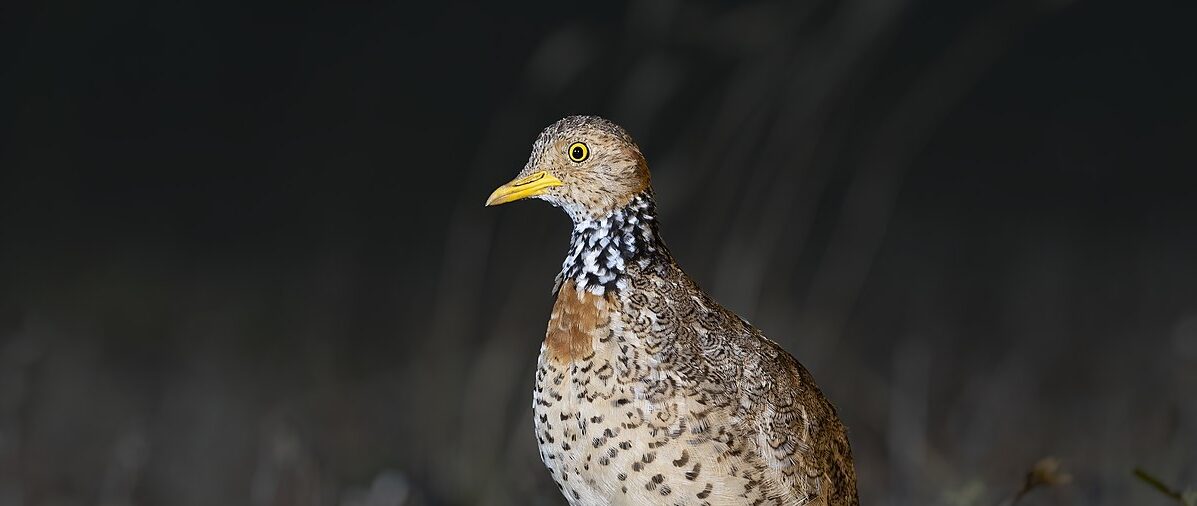The ‘Goldilocks bird’ Plains-wandererPhoto credits: JJ Harrison/Wikipedia The plains-wanderer (Pedionomus torquatus) is a unique and enigmatic native Australian bird. As the only species of the ‘Pedionomidae’ family, despite its quail-like appearance, these birds are believed to be more closely related to a group of South American shorebirds. Standing 15–19cm tall,...
Imagine if… you walked out at night and it was alive with wildlife scurrying and scrapping, digging and dashing. If you couldn’t go far without tripping over a burrow, and the beam of your torchlight sparkled with reflected eye shine.
Australian nights are too quiet now. When the likes of bilbies, boodies, bandicoots and quolls were common, the nights were full of bustle[i]. We see now only a faint shadow of the richness and abundance of the Australian mammal fauna that existed at the time of European settlement[ii].
So begins a new report AVERTING EXTINCTIONS published by the Invasive Species Council in collaboration with Bird Life Australia, Bush Heritage Australia, Australian Land Conservation Alliance and Humane Society International. We were proud to join the report which makes the case for a wildlife revival and a dramatic strengthening of Australia’s threat abatement system. It stresses that this is not an impossible dream.
In the report HSI shares the success we have had addressing albatross bycatch in longline fishing after our nomination saw the Key Threat listed in law in 1998. The longline fishing Threat Abatement Plan, in place for two decades and backed by regulations, is successfully reducing albatross bycatch in Australian waters. It shows what is possible when government agencies, industry and conservationists cooperate and innovate to find solutions, and stay on the case consistently for the long term. It is a success HSI is now seeking to export to fisheries worldwide.
Sadly, the report makes clear that longline fishing is an anomaly. It says the biggest threats to Australian wildlife are running rampant. Bulldozers continue to knock down habitat, cataclysmic wildfires are devastating vast areas, and climate change is driving extreme weather events.
Unless we abate these mega-threats, many more unique species and ecological communities will be doomed to perpetual rarity or extinction.
Australia does have the framework to revive wildlife if only the governments would use the biodiversity provisions of our environment laws as intended and resource them properly. The Environment Protection and Biodiversity Conservation (EPBC) Act enables a 2-pronged approach to threatened species conservation – one prong focused on species recovery and the other on broad-scale threat abatement. As the report says both approaches are essential – but both are failing. Since Australia started officially listing threatened species, only a handful are known to have recovered. Recovery has often been stymied by a lack of effective methods for abating threats and deficient implementation of threat abatement and recovery plans.
The report notes that since the first threatening processes were listed in 1994, the national threatened species list has grown by 70% and Australia has recorded 5 more extinctions of native animals (with 2 species surviving only in captivity).
A concerted focus on threat abatement is needed to enable recovery not only of listed species, but also of the many unlisted species in decline – some on the edge of extinction. It is also essential for fostering resilience, to optimise species’ capacity to adapt under climate change. The development of enduring abatement solutions will also be far less expensive over the long term than ongoing recovery efforts in the face of unrelenting threats.
The Averting Extinctions report calls for 3 reforms:
- Task 1: Strengthen the threat abatement system – focused on improving the statutory processes to list threats and apply effective threat abatement responses.
- Task 2: Secure adequate funding for threat abatement – focused on defining the level of funding needed for effective threat abatement, the economic benefits of abatement and the potential sources of funding.
- Task 3: Inspire a strong national commitment to threat abatement – focused on intergovernmental commitments, nationally coordinated and collaborative threat abatement, community participation and independent oversight of progress.
For the full report click here
[i] Threats to Nature project. 2022. Averting extinctions: The case for strengthening Australia’s threat abatement system. Invasive Species Council, Bush Heritage Australia, BirdLife Australia, the Australian Land Conservation Alliance and Humane Society International
[ii] Woinarski, J. C. Z.; Burbidge, A.; Harrison, P.; et al. The Action Plan for Australian Mammals 2012; CSIRO Publishing, 2014


